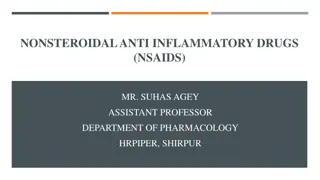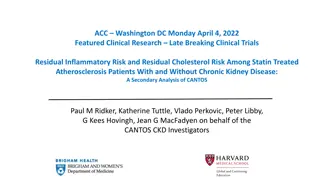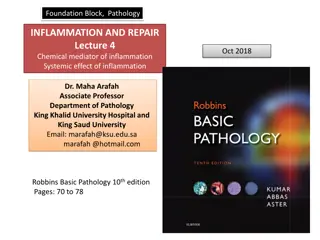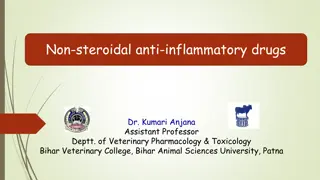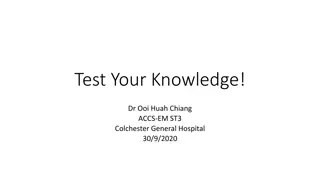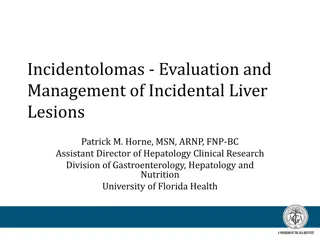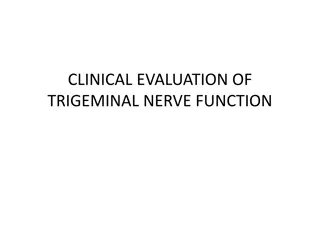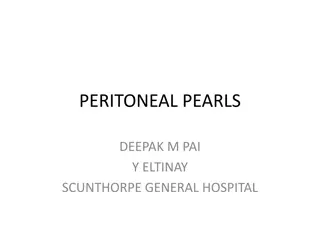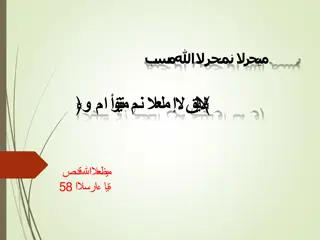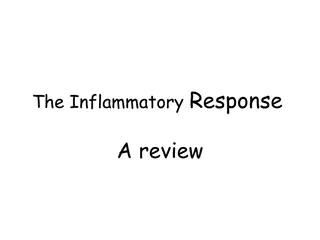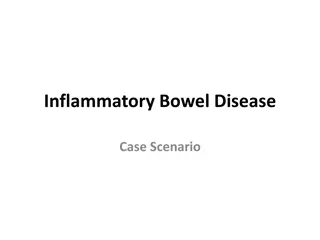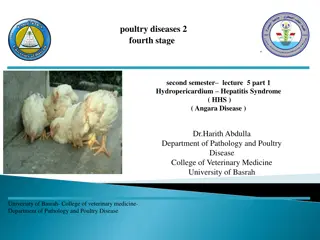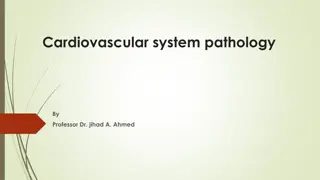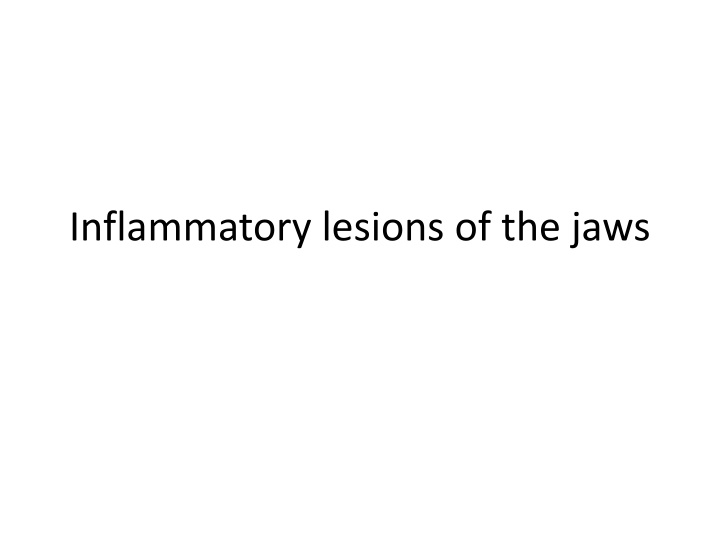
Inflammatory Lesions of the Jaws
Explore the characteristics, radiographic features, and effects of inflammatory lesions affecting the jaws, including periapical inflammation and osteomyelitis. Learn about the clinical manifestations, diagnostic imaging, and management of these conditions.
Download Presentation

Please find below an Image/Link to download the presentation.
The content on the website is provided AS IS for your information and personal use only. It may not be sold, licensed, or shared on other websites without obtaining consent from the author. If you encounter any issues during the download, it is possible that the publisher has removed the file from their server.
You are allowed to download the files provided on this website for personal or commercial use, subject to the condition that they are used lawfully. All files are the property of their respective owners.
The content on the website is provided AS IS for your information and personal use only. It may not be sold, licensed, or shared on other websites without obtaining consent from the author.
E N D
Presentation Transcript
Introduction When the bony lesion is restricted to the region of the tooth, it is called periapical inflammatory lesion When the infection spreads in the bone marrow, it is called osteomyelitis Pericoronitis: inflammation that arises in the tissues surrounding the crown of a partially erupted tooth
General radiographic features Location: 1. In periapical inflammatory lesions: epicentre is tooth apex 2. Periodontal lesions: epicentre at alveolar crest Osteomyelitis is a siffuse, uncontained inflammation of the bone, commonly in posterior mandible Periphery: mostly, it is ill defined
General radiographic features Internal structure: cancellous bone may respond to insult by resorption or deposition of bone In acute disease, resorption predominates In chronic disease, bone formation leading to r opacity In osteomyelitis, film reveals sequestra and appears as ill defined areas of r lucency containing a r opaque island of non vital bone
General radiographic features Effects on surrounding structures: Stimulation of new bone: Sclerotic pattern PDL space: widened, greatest at source of inflammation Chronic infections: root resorption may occur
Periapical inflammatory lesions It is defined as a local response of bone around the apex of a tooth that occurs secondary to necrosis of the pulp or through destruction of the periapical tissues by extensive periodontal disease Asymptomatic to occasional tooth ache to severe pain with or without facial swelling, fever and lymphadenopathy Periapical abscess: Chronic phase:
r/f Early lesions: no radiographic changes seen Chronic stage: r lucent to r opaque or both Location: mostly, epicentre is found at apex of involved tooth Lesion usually starts within the apical portion of the PDL space Periphery: in most cases, it is ill defined, showing a gradual transition from surrounding normal bone into abnormal pattern of lesion Internal structure: early lesions show no change Earliest change seen is loss in bone density, starts a widening of PDL space at apex of a tooth and later involves a larger diameter of surrounding bone
Later in the course of disease, a mixture of sclerosis and rarefaction of bone occurs When increased bone formation occurs, periapical sclersoing osteitis is the preferred term When most of lesion is undergoing resorption, periapical rarefying osteitis is used Resorption is centered at centre of lesion and sclerosis at periphery In chronic cases, new bone formation may result in a very dense sclerotic region of bone called sclerosing osteitis
Effects on surrounding structures: lamina dur around apex is usually lost In chronic cases, external resorption of apical region may occur Long standing cases, pulp canal may appear wider Cortical boundaries may be destroyed
Pericoronitis Syn: operculitis It refers to inflammation of the tissues surrounding the crown of a partially erupted tooth Gingiva surrounding the erupted portion of crown becomed inflammed when debris get trapped under the flap Gingiva subsequently becomes swollen and may be traumatized by opposing occlusion
Clinical features Pts typically c/o pain and swelling Trismus is a common presentationwhen lower 3rd molar is partially impacted An ulcerated operculum is the source of pain Any age pts and gender
Radiographic features Location: mandibular 3rdmolar region is the most common location Periphery: ill defined with a gradual transition of normal trabecular pattern into a sclerotic region Internal structure: internal structure of bone adjacent to pericoronitis most often is sclerotic with thick trabeculae An area of bone loss or r lucency adjacent to crown may be seen that enlarges the follicular space Effects on surrounding structures: it causes typical changes of sclerosis and rarefaction of surrounding bone In severe cases, periosteal new bone formation is seen
Management Removal of partially erupted tooth Trismus: antibiotic therapy and reduction in occlusion of opposing tooth
Osteomyelitis It is inflammation of bone Inflammatory process may spread through the bone to involve the marrow, cortex, cancellous portion and periosteum The bacteria and their products stimulate an inflammatory reaction in bone, causing destruction of the endosteal surface of cortical bone This destruction may progress through the cortical bone to outer periosteum The periosteum is lifted up by inflammatory exudate and new bone is laid down Hall mark is presence of sequestra Sequestra is a segment of bone that has become necrotic coz of ischemic injury caused by inflammatory process
Acute phase chronic phase Garre s osteomyelitis: exuberant periosteal response to inflammation Diffuse sclerosing osteomyelitis: is a chronic form of osteomyelitis with a pronounced sclerotic response
Acute phase Syn: acute suppurative osteomyelitis Pyogenic osteomyelitis Subacute suppurative osteomyelitis Garre s osteomyelitis Proliferative periostitis Periostitis ossificans C/F: all ages people are affected Male predilection More common in mandible Rapid onset, pain and swelling of adjacent soft tissues Fever, lymphadenopathy, leukocytosis
Associated teeth may be mobile and sensitive to percussion Purulent drainage may also be present Paresthesia of lower lip is not uncommon R/G: location: posterior body of mandible Periphery: acute phase presents as ill defined periphery with gradual transition to normal trabeculae Internal structure: 1stevidence is slight decrease in density of involved bone, with loss of sharpness of existing trabeculae In time bone destruction becomes profound and forms an area of r lucency in focal area or scattered
Effects on surrounding structures: acute phase can stimulate either bone resorption or formation Portions of cortical bone may be resorbed Inflammatory exudate can lift the periosteum and stimulate new bone and appears as a thin, faint, r opaque line adjacent to and almost parallel or slightly convex to bone surface
Chronic phase Syn: chronic diffuse sclerosing osteomyelitis Chronic nonsuppurative osteomyelitis Chronic osteomyelitis with proliferative periostitis Garre s chronic nonsuppurative sclerosing osteitis It can be de novo or if acute phase not treated The symptoms are less severe and have a longer history Intermittent, recurrent episodes of swelling, pain, fever and lymphadenopathy Paresthesia and drainage with sinus formation may also occur Diffuse sclerosing osteomyelitis is chronic one and bone metabolism is tipped toward increased bone formation
Radiologic features Location: posterior mandible Periphery: better defined than in acute A gradual transition is seen at border Internal structure: comprises of greater and lesser r opacity Commonly has r opacity/sclerosis seen In other cases, small regions of r lucency may be scattered throughout the r opaque bone Close inspection reveals an island of bone or sequestrum within the centre
Effects on surrounding structures: chronic phase stimulates the formation of periosteal new bone, seen as a single r opaque line parallel to surface of cortical bone Over time the r lucent strip from the outer cortical bone may be filled in with granular sclerotic bone Roots of teeth may undergo external resorption and lamina dura may become less apparent Chronic form may spread to condyle resulting in septic arthritis
Osteoradionecrosis Refers to an inflammatory condition of bone that occurs after the bone has been exposed to therapeutic doses of radiation usually given for a malignancy of head and neck region It is characterized by presence of exposed bone for a period of atleast 3 months occuring at any time after the delivery of radiation therapy Doses above 50 Gy are required to cause this irreversible damage Bone that is been exposed is hypocellular and hypovascular Hypovascularity results in hypoxic environment in which adequate healing of bone is not possible
Clinical features Mandible is more commonly affected Loss of mucosal covering and exposure of bone is hallmark of osteoradionecrosis Pathologic fracture may also occur Exposed bone becomes necrotic as a result of loss of vascularity from periosteum and subsequently sequestrates, leading to exposure of more bone Pain may or may not be present Intense pain may occur, with intermittent swelling and drainage extraorally
Radiographic features Location: posterior mandible Periphery: is ill defined. If lesion reaches inferior border of mandible, irregular resorption of this bony cortex often occurs Internal structure: bone resorption to formation occurs. More of sclerosis occurs, with granular bone pattern Scattered regions of r lucency may be seen, with or without sequestra Effects on surrounding structures: new bone formation is uncommon due to effect of radiation of osteoblasts. Sclerosis may be seen at inferior border

